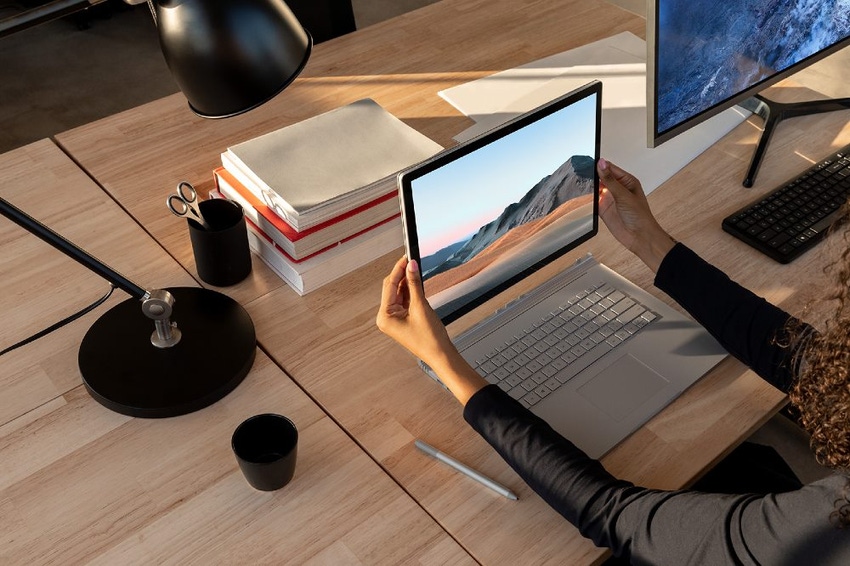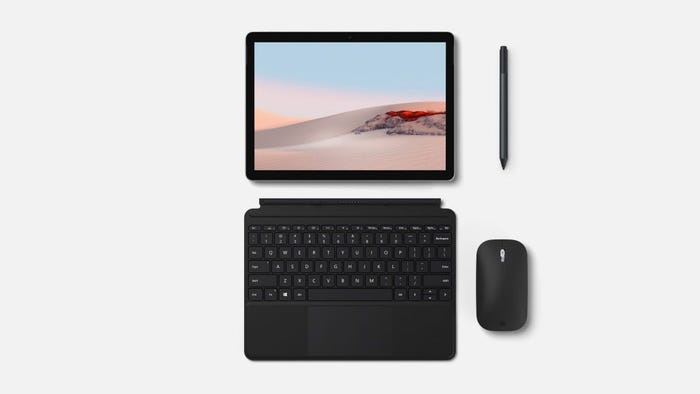Microsoft Adds New Surface PCs, Delays Dual-Screen, Foldable Devices
The Surface Go 2, Surface Book 3 and Surface Dock upgrade will ship this month.
May 7, 2020

Microsoft will offer two new Surface PCs this month, along with a much-needed upgrade of its Surface Dock.
The company, however, has iced plans to introduce dual-screen and foldable Surface PCs based on its forthcoming Windows 10X operating system.
Microsoft last fall had revealed Windows 10X, setting expectations that foldable and dual-screen Surface PCs might appear later this year. In addition to showing prototypes of its Surface Duo and Surface Neo devices, OEMs previewed devices in the works. Among them, Dell and Lenovo displayed planned foldables at the Consumer Electronics (CES) show in January.
Since then, much has changed. The leader of Microsoft’s Surface PC group, Panos Panay, now also oversees the company’s Windows software and devices organization. Panay earlier this week signaled the change in Windows 10X’s near-term focus.
“The world is a very different place than it was last October when we shared our vision for a new category of dual-screen Windows devices,” Panay wrote in a blog. “We need to focus on meeting customers where they are now. Our customers are leveraging the power of the cloud more than ever, and we believe the time is right to lean into this acceleration in a different way. With Windows 10X, we designed for flexibility. That flexibility has enabled us to pivot our focus toward single-screen Windows 10X devices that leverage the power of the cloud to help our customers work, learn and play in new ways.”
Panay was vague about Microsoft’s plans for foldables and dual-screen PCs and what Windows 10X will bring to single-screen devices.
Here’s our most recent list of new products and services being offered by agents, VARs, MSPs and other channel partners. |
“These single-screen devices will be the first expression of Windows 10X that we deliver to our customers,” he noted. “We will continue to look for the right moment, in conjunction with our OEM partners, to bring dual-screen devices to market.”
COVID-19 Shifts Priorities
Industry analyst Jack Gold of J. Gold Associates said the move isn’t a major surprise, considering the impact of COVID-19.
“Right now, I don’t think many people are thinking about new dual-screen devices,” Gold said. “I suspect few device makers have the appetite for entering a new product space with the uncertainties around the pandemic. Totally new product classes can wait until things calm down a bit, although who knows how long that will take.”
Keep up with the latest developments in how the channel is supporting partners and customers during the COVID-19 crisis. |
Overall, demand for Microsoft’s Surface PCs has remained strong. During the fourth quarter of 2019, sales of Surface PCs rose 11%, falling shy of $2 billion. COVID-19 helped boost sales of Surface PCs higher than expected for the first quarter of 2020, Microsoft reported last week.
Microsoft typically refreshes some of its Surface PCs in the spring, with more substantial hardware launches in the fall. Back in October when Microsoft uncharacteristically offered a glimpse of Windows 10X, it rolled out three new Surface PCs. They were the Surface Laptop 3, Surface Pro 7 and the Surface Pro X. The Pro X was the first ARM-based Surface Pro with LTE, co-developed with Qualcomm.
The spring launch, Wednesday, was considerably more modest, consisting of upgrades to some of its lower profile Surface PCs. The Surface Go 2 and Surface Book 3 give a boost to Microsoft’s entry-level and high-end devices.
“Each one of these products [is]made to adapt to you so you can stay in your flow, work, learn, and have fun, from anywhere,” Panay wrote Wednesday on Twitter.
Surface Go 2

Microsoft Surface Go 2
Microsoft will ship the 10.5-inch Surface Go 2 next week, starting at $399 The workstation-class Surface Book 3, slated for delivery May 21, will range from $1,599 to $3,499.
As the prices suggest, the two devices appeal to completely different types of users. The 10.5-inch Surface Go is an upgrade of the original small-form factor, convertible tablet PC launched two years ago. Weighing 1.2 pounds without the optional keyboard, the Surface Go 2 is Microsoft’s alternative to Chromebooks.
The Surface Go 2 is loaded with Microsoft’s Windows 10 S, the scaled down OS. Windows 10 S only runs web apps and Universal Windows Platform (UWP)-developed software. Consequently, that means the Surface Go 2 devices with Windows 10 S won’t run traditional Win32 applications.
Customers who buy the Surface Go 2 through commercial channels can get …
… around that by upgrading to Windows 10 Pro. While the upgrade is included, considering the Surface Go 2’s hardware, Win32 apps will likely run rather slow.
The base Surface Go 2 comes with Intel’s Pentium Gold Processor 4425Y, 4GB of RAM and a 64GB eMMC. Options include an 8th Gen Core m3 processor, 8 GB of RAM and a 128 GB SSD.
“It’s not a high-power device but for many tasks, especially in Edu, it is more than adequate,” analyst Gold said. “And since it runs Windows, there are lots of apps for the device. But managing a Windows device is more complex than managing a Chromebook, which might make a difference in some markets.”
Surface Book 3
At the other end of the spectrum, Microsoft launched its Surface Book 2 in late 2017. The new Surface Book 3 (pictured at the top of this page), like its predecessors, is available with either 13.5-inch or 15-inch displays. Both are built with Intel 10th Gen processors and NVIDIA GPUs, and support up to 32 GB of RAM. In addition to support for Wi-Fi 6, Microsoft has embedded Xbox Wireless into the 15-inch models.
“They’re going after the gaming and the creators’ market and not the mass market,” analyst Gold said. “Starting at $1,599, it’s not inexpensive. The Surface Book has not been a massive seller, but it does have a following.”
Surface Dock 2
Microsoft is rolling out several other peripherals. Among them are the Surface Dock 2, USB-C Travel Hub, Surface Headphones 2, Surface Earbuds and a new ergonomic keyboard.
Partners could find that many of their commercial and enterprise customers are most interested in the Surface Dock 2. Microsoft launched the current Surface Dock nearly five years ago with the Surface Pro 4. The Surface Dock 2 will have 4 USB-C-3.2 ports, two USB-3 ports, a 3.5 mm headphone and microphone jack, a gigabit Ethernet port, and power the two USB C 3.2 ports in the back drive external displays. Two of the USB-C ports can connect two 4k displays at 60 Hz or 5k displays at 30 Hz.
The Surface Dock 2 costs $259. It also offers enterprise management that allows certificate-based management, among other controls.
Read more about:
AgentsAbout the Author(s)
You May Also Like


